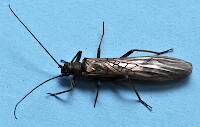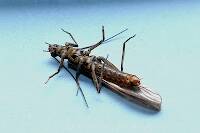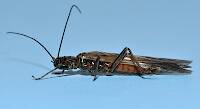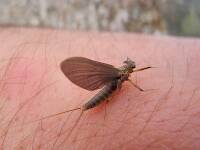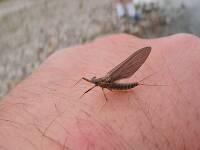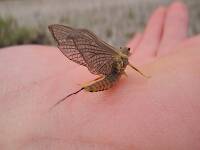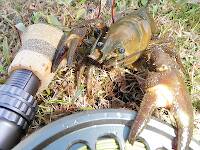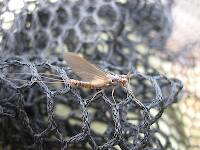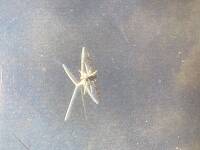
Blue-winged Olives
Baetis
Tiny Baetis mayflies are perhaps the most commonly encountered and imitated by anglers on all American trout streams due to their great abundance, widespread distribution, and trout-friendly emergence habits.
Featured on the forum

This wild-looking little thing completely puzzled me. At first I was thinking beetle or month larva, until I got a look at the pictures on the computer screen. I made a couple of incorrect guesses before entomologist Greg Courtney pointed me in the right direction with Psychodidae. He suggested a possible genus of Thornburghiella, but could not rule out some other members of the tribe Pericomini.

Troutnut is a project started in 2003 by salmonid ecologist Jason "Troutnut" Neuswanger to help anglers and
fly tyers unabashedly embrace the entomological side of the sport. Learn more about Troutnut or
support the project for an enhanced experience here.
Isidro
Posts: 24
Posts: 24
Isidro on Mar 3, 2008March 3rd, 2008, 6:57 pm EST
I don't know how in Earth I gave this identification, years ago, to this very common mayfly in my zone. Maybe looking a book I've found one similar with this name. But unfortunately, there are any adult picture of Choroterpes in the web. Leptophlebiidae is sure, and females are very difficut to see, while the males (turbinate eyes) are very common into my city (Zaragoza, NE Spain). Posterior wings are very small, and costal zone very dark. Wingspan is about 15 mm. Two cerci.
The rivers of the zone are big, deep, contaminated and slow.

Thanks a lot.
Regards,
Isidro
The rivers of the zone are big, deep, contaminated and slow.

Thanks a lot.
Regards,
Isidro
Konchu on Mar 4, 2008March 4th, 2008, 2:59 pm EST
The eyes are hard to see from my machine, but could this be a baetid? Why do you assume Leptophlebiidae?
Isidro
Posts: 24
Posts: 24
Isidro on Mar 4, 2008March 4th, 2008, 7:15 pm EST
Thanks Konchu. Maybe it's a baetid, but due to elongate wings, turbinate eyes, posterior wings present... I thinked that was identical to Leptophlebiidae. Now I need a genus -and, if it's possible, species- level identification ;-)
Troutnut on Mar 11, 2008March 11th, 2008, 4:41 pm EDT
It looks like a Baetid to me, too. The features you listed aren't incompatible with that ID. As for species and genus, I doubt we can be of much help. Even a series of high-quality closeups like I've got on this site often isn't sufficient to figure out genus and species for Baetid mayflies, even well-known American species.
Jason Neuswanger, Ph.D.
Troutnut and salmonid ecologist
Troutnut and salmonid ecologist
Isidro
Posts: 24
Posts: 24
Isidro on Mar 11, 2008March 11th, 2008, 10:43 pm EDT
Many thanks Jason. Then, is not a Choroterpes but a Baetid... It's a pity that the ID was impossible...
Isidro
Posts: 24
Posts: 24
Isidro on May 18, 2008May 18th, 2008, 12:57 am EDT
There is a lost answer??? taxon answered the last, in the forum says "6 answers", but I entrer and see my answer the last and only 5 answers...
Taxon on May 18, 2008May 18th, 2008, 2:23 pm EDT
Isidro-
Not a lost answer, just a deleted answer. Taxon had just run across a photo of dun with a fore wing which was similar to the one in your photo, and impulsively posted a comment, but promptly changed his mind and deleted it. Incidentally, the photo was in the book Trout Fly Recognition by John Goddard, and the photo was labeled Leptophlebia vespertina female dun.
Not a lost answer, just a deleted answer. Taxon had just run across a photo of dun with a fore wing which was similar to the one in your photo, and impulsively posted a comment, but promptly changed his mind and deleted it. Incidentally, the photo was in the book Trout Fly Recognition by John Goddard, and the photo was labeled Leptophlebia vespertina female dun.
And on Jun 4, 2008June 4th, 2008, 10:40 am EDT
Hello Isidro,
Choroterpes (like all Leptophlebiidae) has always 3 cerci
Greetings
Andrea
Choroterpes (like all Leptophlebiidae) has always 3 cerci
Greetings
Andrea
Quick Reply
Related Discussions
Topic
Replies
Last Reply
13
Mar 27, 2008
by Martinlf
by Martinlf
2
Mar 26, 2008
by Isidro
by Isidro







